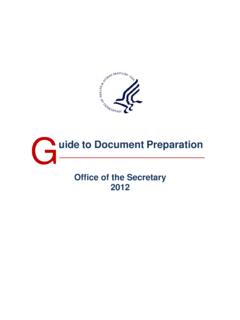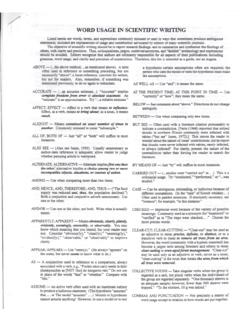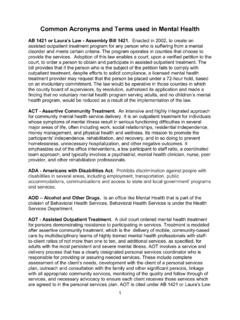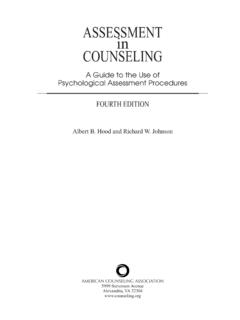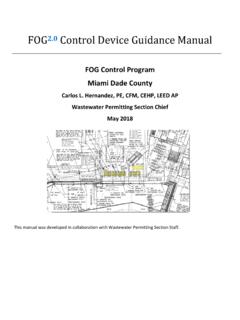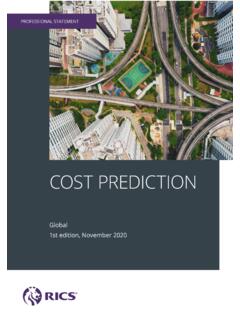Transcription of Glossary A guide to common planning terms and acronyms
1 Glossary A guide to common planning terms and acronyms Introduction This Glossary offers a plain word definition of some of the most commonly used terms in planning . Its status is purely as an introductory quick reference guide and it should not be used as a source for statutory definitions. Term Description Accessibility The ability of people to move around an area and reach places and facilities, including elderly and disabled people, those with young children and those encumbered with luggage or shopping. Adopted Proposals Map A component of a Local Development Framework and an important part of the development plan, or DPD itself, showing the location of proposals in all current Development Plan Documents, on an Ordnance Survey base map. Adoption The final confirmation of a development plan or Local Development Document status by a local planning authority (LPA). Affordable Housing (or sub market housing) Housing, whether for rent, shared ownership or outright purchase, provided at a cost considered affordable in relation to incomes that are average or below average, or in relation to the price of general market housing.
2 Ancillary Use / Operations A subsidiary or secondary use or operation closely associated with the main use of a building or piece of land. Annual Monitoring Report (AMR) A report submitted to the government by local planning authorities or regional planning bodies assessing progress with and the effectiveness of a Local Development Framework. Appeal The process whereby a planning applicant can challenge an adverse decision, including a refusal of permission. Appeals can also be made against the failure of the planning authority to issue a decision within a given time, against conditions attached to permission, against the issue of an enforcement notice and against refusals of listed building and conservation area consent. In England and Wales, appeals are processed by the planning Inspectorate. Area Action Plan A type of Development Plan Document focused upon a specific location or an area subject to conservation or significant change (for example major regeneration).
3 Area of Outstanding Natural Beauty (AONB) An area with a statutory national landscape designation, primary purpose of which is to conserve and enhance natural beauty. Together with National Parks, AONB, represent the nation's finest landscapes. AONB s are designated by the Countryside Agency. Article 4 Direction Direction removing some or all permitted development rights, for example within a conservation area or curtilage of a listed building. Article 4 directions are issued by local planning authorities. Backland development Development of 'landlocked' sites behind existing buildings, such as rear gardens and private open space, usually within predominantly residential areas. Such sites often have no street frontages. Biodiversity The whole variety of life encompassing all genetics, species and ecosystem variations, including plans and animals. Biomass Living matter within an environmental area, for example plant material, vegetation, or agricultural waste used as a fuel or energy source.
4 Breach of Condition Notice A notice served by a local planning authority where they suspect that a planning condition linked to a planning permission has been breached. Brownfield Land and Sites Previously developed land which is or was occupied by a permanent structure, including the curtilage of the developed land and any associated fixed surface infrastructure. Also see 'Previously Developed Land'. Change of Use A change in the way that land or buildings are used (see Use Classes Order). planning permission is usually necessary in order to change from one 'use class' to another. Circular A government publication setting out procedural matters and guidance. Community Strategy A strategy prepared by a local authority to improve local quality of life and aspirations, under the Local Government Act 2000. Compulsory Purchase Order (CPO) An order issued by the government or a local authority to acquire land or buildings for public interest purposes.
5 For example, for the construction of a major road or the redevelopment of certain brownfield sites. Conditions (or ' planning condition') Requirements attached to a planning permission to limit, control or direct the manner in which a development is carried out. Conservation Area Areas of special architectural or historic interest, the character or appearance of which it is desirable to preserve or enhance. Conservation Area Character Appraisal A published document defining the special architectural or historic interest that warranted the area being designated. Conservation Area Consent Consent required for the demolition of an unlisted building within a conservation area. Contaminated Land Land that has been polluted or harmed in some way making it unfit for safe development and usage unless cleaned. Conversions Generally means the physical work necessary to change of use of a building from a particular use, classified in the use classes order, to another use.
6 Can also mean the sub division of residential properties into self contained flats or maisonettes. Core strategy A Development Plan Document setting out the spatial vision and strategic objectives of the planning framework for an area, having regard to the Community Strategy (see also DPDs). Curtilage The area normally within the boundaries of a property surrounding the main building and used in connection with it. Density In the case of residential development, a measurement of either the number of habitable rooms per hectare or the number of dwellings per hectare. Design Statement A design statement can be made at a pre planning application stage by a developer, indicating the design principles upon which a proposal is to be based. It may also be submitted in support of a planning application. Detailed Application / Full application A planning application seeking full permission for a development proposal, with no matters reserved for later planning approval.
7 Determination The process by which a local planning authority reaches a decision on whether a proposed development requires planning permission. Development Development is defined under the 1990 Town and Country planning Act as "the carrying out of building, engineering, mining or other operation in, on, over or under land, or the making of any material change in the use of any building or other land." Most forms of development require planning permission (see also "permitted development"). Development Plan A document setting out the local planning authority's policies and proposals for the development and use of land and buildings in the authority's area. It includes Unitary, Structure, and Local Plans prepared under transitional arrangements. It also includes the new look Regional Spatial Strategies and Development Plan Documents prepared under the planning & Compulsory Purchase Act of 2004. Development Plan Documents (DPDs) Development Plan Documents are prepared by local planning authorities and outline the key development goals of the local development framework.
8 Development Plan Documents include the core strategy, site specific allocations of land and, where needed, area action plans. There will also be an adopted proposals map which illustrates the spatial extent of policies that must be prepared and maintained to accompany all DPDs. All DPDs must be subject to rigorous procedures of community involvement, consultation and independent examination, and adopted after receipt of the inspector's binding report. Once adopted, development control decisions must be made in accordance with them unless material considerations indicate otherwise. DPDs form an essential part of the Local Development Framework. Dwelling & Dwelling house A self contained building or part of a building used as a residential accommodation, and usually housing a single household. A dwelling may be a house, bungalow, flat, maisonette or converted farm building. Eco towns Exemplar "green developments".
9 They will meet the highest standards of sustainability, including low and zero carbon technologies and quality public transport systems. They will make use of brownfield land and surplus public sector land where practical and lead the way in design, facilities and services, and community involvement Elevation The actual facade (or face) of a building, or a plan showing the drawing of a facade. Enforcement Action Procedures by a local planning authority to ensure that the terms and conditions of a planning decision are carried out, or that development carried out without planning permission is brought under control. Enforcement Notice A notice served by a local planning authority setting out the remedial action necessary to put right work or correct an activity that appears to have been undertaken without planning permission. Environment Agency A government body that aims to prevent or minimise the effects of pollution on the environment and issues permits to monitor and control activities that handle or produce waste.
10 It also provides up to date information on waste management matters and deals with other matters such as water issues including flood protection advice. Environmental Impact Assessment (EIA), and Environmental Statement (EA) Applicants for certain types of development, usually more significant schemes, are required to submit an "environmental statement" accompanying a planning application. This evaluates the likely environmental impacts of the development, together with an assessment of how the severity of the impacts could be reduced. Flood plain Generally low lying areas adjacent to a watercourse, tidal lengths of a river or the sea, where water flows in times of flood or would flow but for the presence of flood defences. Flood Risk Assessment An assessment of the likelihood of flooding in a particular area so that development needs and mitigation measures can be carefully considered. Fossil Fuels (a non renewable fuel) Carbon rich fuel (coal, oil and natural gas) formed from the remains of ancient animals and plants.


